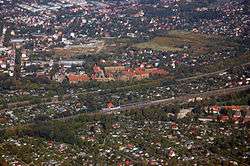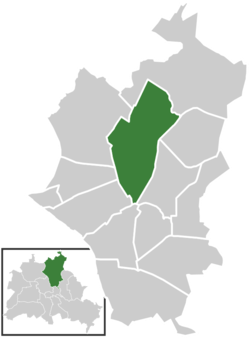Französisch Buchholz
Französisch Buchholz,[1] also known simply as Buchholz, is a German locality (Ortsteil) within the Berlin borough (Bezirk) of Pankow.
Französisch Buchholz | |
|---|---|
Quarter of Berlin | |
 Aerial view with Blankenburg (in south) | |
 Coat of arms | |
Location of Französisch Buchholz in Pankow and Berlin  | |
 Französisch Buchholz  Französisch Buchholz | |
| Coordinates: 52°37′07″N 13°23′24″E | |
| Country | Germany |
| State | Berlin |
| City | Berlin |
| Borough | Pankow |
| Founded | 1242 |
| Area | |
| • Total | 12 km2 (5 sq mi) |
| Elevation | 80 m (260 ft) |
| Population (2008-06-30) | |
| • Total | 18,766 |
| • Density | 1,600/km2 (4,100/sq mi) |
| Time zone | CET/CEST (UTC+1/+2) |
| Postal codes | (nr. 0310) 13127 |
| Vehicle registration | B |
| Website | Official website |
History
First mentioned in 1242 as Buckholtz in a document, it became the property of Frederick William I in 1670. In 1685, after the Edict of Potsdam, it was formed as a French colony (Französische Kolonie), a residence for French Huguenots. An autonomous municipality of Brandenburg, named Berlin-Buchholz after 1913, it was merged into Berlin in 1920 by the "Greater Berlin Act". From 1949 to 1990 it was part of East Berlin.[2]
Geography
Located in the northern suburbs of the city, but totally surrounded by the territory of Berlin, Buchholz borders on Buch, Karow, Blankenburg, Pankow, Niederschönhausen, Rosenthal and Blankenfelde. In the north of the quarter is situated the natural reserve "Karower Teiche", part of the Barnim Nature Park.[3]
Transport
Crossed by the S-Bahn line S8 and by the Heidekrautbahn, it is not directly served by urban railways except for the tramway line 50, that passes through all the quarter. The nearest S-Bahn stations are Blankenburg and Pankow-Heinersdorf, situated on the lines S2, S8 and S9. Französisch Buchholz is also traversed, at its northern borders, by the Berliner beltway (A10, known as "Berliner Ring"), that is linked to the short motorway A114. The exits n.2 ("Schönerlinder Straße"), n.3 (Bucher Straße) and n.4 ("Pasewalker Straße") serve the locality.
Photogallery
 View of the natural reserve "Karower Teiche"
View of the natural reserve "Karower Teiche".jpg) Tram stop at Rosenthaler Straße (line 50)
Tram stop at Rosenthaler Straße (line 50) Feierhalle at the local cemetery
Feierhalle at the local cemetery
References
- The word Französisch stands for "French"
- (in German) Detailed historical chronicles of Französisch Buchholz Archived 6 March 2012 at the Wayback Machine
- Infos on the NPB official website. Click on "Naturpark", then click on "Region"
External links
![]()
- (in German) Französisch Buchholz official website